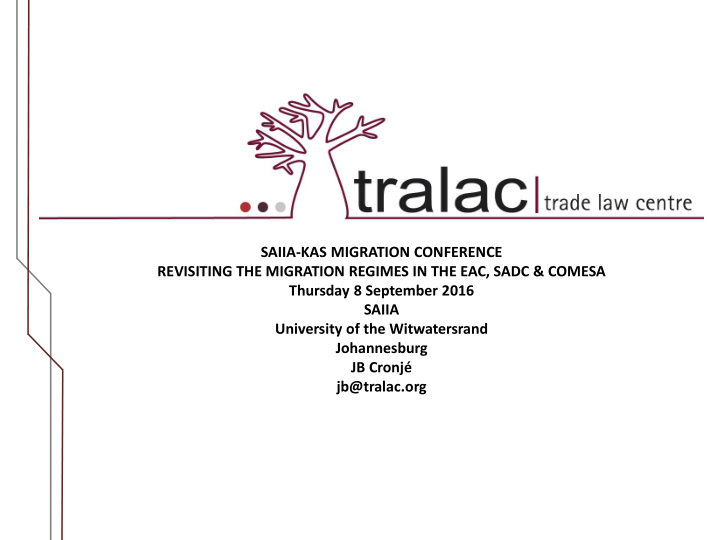



SAIIA-KAS MIGRATION CONFERENCE REVISITING THE MIGRATION REGIMES IN THE EAC, SADC & COMESA Thursday 8 September 2016 SAIIA University of the Witwatersrand Johannesburg JB Cronjé jb@tralac.org
Migration Trends in the EAC and SADC 1. Migration terminology 2. Migration a global phenomenon (World Migration Report 2015) 232m international migrants and 740 internal – migrants 34m international migrants from Africa – 18m live in other African states – 50% live in only 10 countries – About 8.7m migrant works in Africa (ILO 2013) –
Migration Trends in the EAC and SADC Migration stocks and flows in the East African region and the top source countries in Africa for inward migration Country Total inward Total outward Top 3 African origin countries for inward migrants migrants migrants Burundi 290 280 DRC (170) Rwanda (60) Tanzania (30) Kenya 1 008 460 Somalia (490) Uganda (330) S-Sudan (90) Rwanda 440 320 DRC (230) Uganda (90) Burundi (60) South-Sudan 820 630 Sudan (550) Uganda (140) DRC(80) Tanzania 260 290 Burundi (90) DRC (60) (Kenya (30) Uganda 750 740 DRC (300) Sudan (160) Rwanda (80) Source: United Nations, Department of Economic and Social Affairs (2015). Trends in International Migrant Stock: Migrants by Destination and Origin (United Nations database, POP/DB/MIG/Stock/Rev.2015). *numbers are in thousand
Migration Trends in the EAC and SADC • Two broad trends in Eastern Africa: – From the DRC and Horn of African countries to adjacent neighbouring countries • Political instability and conflict – Within the EAC • Regional economic integration (EAC Common Market Protocol) • Free movement of workers and right of establishment • Mutual recognition of academic and professional qualifications • EAC passport
Migration Trends in the EAC and SADC Migration stocks and flows in the Southern African region and the top source countries in Africa for inward migration Total Total Top 3 African origin countries for inward migrants Country inward outward migrants migrants Botswana 160 60 SA (40) Zimbabwe (30) Zambia (10) Malawi 300 220 Mozambique (50) Zambia (40) Zimbabwe (40) Mozambique 220 710 Malawi (80) Zimbabwe (30) SA (10) Namibia 90 150 Angola (30) Zimbabwe (10) SA (10) SA 3 140 840 Zimbabwe (480) Mozambique (450) Lesotho (350) Zambia 130 240 Zimbabwe (20) Angola (20) DRC (10) Zimbabwe 400 860 Malawi (100) Mozambique (90) Zambia (30) Source: United Nations, Department of Economic and Social Affairs (2015). Trends in International Migrant Stock: Migrants by Destination and Origin (United Nations database, POP/DB/MIG/Stock/Rev.2015). *numbers are in thousand
Migration Trends in the EAC and SADC General trend toward South Africa: • Top destination for international migrants in Africa • Large and diversified economy • Hosts largest number of refugees and asylum- seekers in Africa (5 th largest in world) – allowed to integrate and work • Neighbouring countries sources of migrant mine workers for over a century
Migration Trends in the EAC and SADC South Africa developing new international migration policy: • Major tourist destination, transit hub, venue for international events, filmmaking and astronomy • 90% of 15m arrivals of foreign visitors in 2014 from SADC • Experiencing large shortages of skilled workers • To bring domestic policy in line with African development agenda
Migration Trends in the EAC and SADC Highlights of SA’s proposed international migration policy: • Risk-based approach to international migration – Traveller identification system • bona fide travellers long-term multiple entry visas • Abolish transit visas • Establish an integrated border management authority • More stringent residency and naturalisation requirements
Migration Trends in the EAC and SADC Highlights of SA’s proposed international migration policy: • Better management of international migrants with skills and capital – Long-term work visas – Preserve family units – Permanent residence or long-term work visas for international students graduating from SA universities
Migration Trends in the EAC and SADC Highlights of SA’s proposed international migration policy: • Improve engagement with SA emigrants abroad – Remittances – Labour and study exchange programmes – Skills transfer and investment • More stringent asylum-seeker and refugee legislation – Bilateral agreements with neighbouring countries
Migration Trends in the EAC and SADC Highlights of SA’s proposed international migration policy: • Consideration of historical and geopolitical migration patterns in Africa – SADC Protocol on Free Movement of Persons • Visa-free entry • Residence and establishment (income generating activities) • Not yet in force • SA is applying visa-free entry for 11 SADC Members on unilateral or bilateral basis & special permits for irregular migrants from Lesotho and Zimbabwe
Migration Trends in the EAC and SADC Highlights of SA’s proposed international migration policy: • Consideration of historical and geopolitical migration patterns in Africa – SADC Protocol on Training and Development • Freer movement of students and academic staff – SADC Protocol on Tourism • UNIVISA for visitors from outside the region – SADC Protocol on Trade in Services • Temporary movement of persons supplying a service • Mutual recognition of qualifications and licences
Migration Trends in the EAC and SADC Highlights of SA’s proposed international migration policy: • Consideration of historical and geopolitical migration patterns in Africa – Proposed visas for neighbouring countries and Malawi • Quota-based work visa (will not obtain permanent residence) • Long-term multiple entry visa for frequent cross-border traders • SME-visa for self-employed
Migration Trends in the EAC and SADC Highlights of SA’s proposed international migration policy: • Consideration of historical and geopolitical migration patterns in Africa – African Union Agenda 2063 • Establishment of Continental FTA • Continent-wide visa-free or visa on arrival regime for African citizens Could SA’s new policy help shape and accelerate ongoing negotiations in SADC, CFTA and TFTA?
Thank you for your attention Questions JB Cronjé Researcher, Trade Law Centre (tralac) Tel: +27 21 880 2010 jb@tralac.org www.tralac.org
Recommend
More recommend